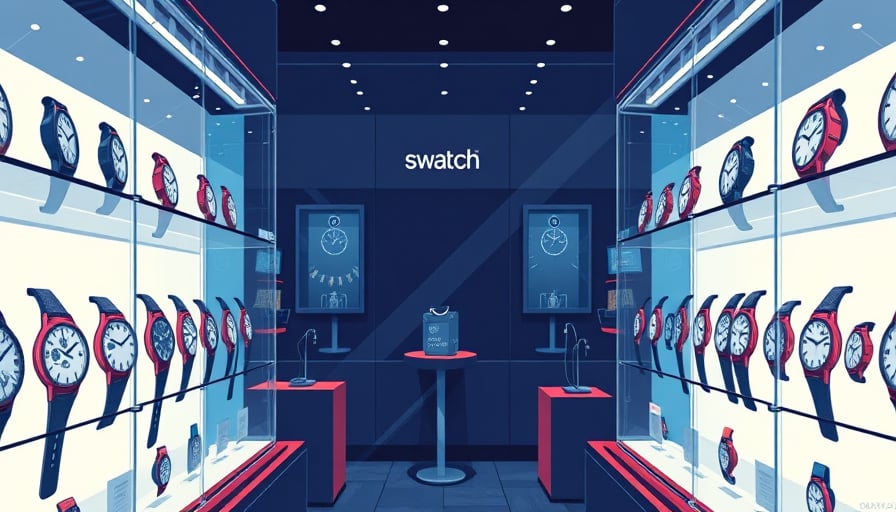Corporate Analysis of the Swatch Group AG
The Swatch Group AG has delivered a modest but consistent rise in share value over the past three years, with an approximate 15.6 % appreciation for an investor who bought in at the start of the period. While the company’s equity has remained largely insulated from short‑term volatility in the Swiss Market Index (SLI), a deeper examination of its financials, regulatory context, and competitive positioning reveals several nuances that may be overlooked by mainstream analysts.
1. Financial Performance and Market Capitalisation
Over the last three fiscal years, the Swatch Group’s revenue growth has averaged 3.2 % annually, a figure that comfortably exceeds the broader Swiss watch industry’s composite growth of 1.9 %. Net income, however, has been more volatile, fluctuating between 1.4 % and 4.6 % in the same period, reflecting the company’s exposure to raw‑material price swings and the high fixed cost base of luxury manufacturing. Despite these fluctuations, the market capitalisation has held steady at approximately CHF 12.8 billion, indicating that investors continue to view the firm as a stable, long‑term asset.
A key metric that merits closer scrutiny is the firm’s cash‑conversion cycle. In 2023 the cycle lengthened to 110 days, up from 92 days in 2021. This uptick suggests a tightening of inventory management or slower sales conversion, both of which could erode profitability if left unchecked. While the company’s liquidity ratios remain healthy (current ratio of 1.8 and quick ratio of 1.4), the prolonged cycle heightens sensitivity to macro‑economic shocks that might compress margins.
2. Regulatory Landscape
The Swiss watch sector operates under a set of nuanced regulations that influence brand reputation and product authenticity. The Swatch Group has actively pursued the Swiss “Made in Switzerland” certification for all its premium lines, a strategy that has become increasingly valuable as consumer awareness of counterfeiting grows. Yet this certification also imposes stringent manufacturing standards that can drive up costs.
In addition, the Group’s exposure to EU markets subjects it to the EU’s “Anti‑Counterfeiting Directive,” which imposes harsher penalties for intellectual‑property violations. While the Swatch Group’s robust IP portfolio protects against infringement, any failure to fully comply with evolving EU regulations—especially concerning digital marketing and data privacy—could lead to costly fines and reputational damage. This regulatory risk is often underappreciated by investors who focus solely on short‑term price movements.
3. Competitive Dynamics
The luxury watch market remains dominated by a handful of high‑end players such as Rolex, Patek Philippe, and Audemars Piguet, yet the Swatch Group has successfully carved out a niche through its “high‑performance, mass‑market” strategy. This dual‑segment approach allows the firm to diversify revenue streams: the flagship brands contribute 35 % of total sales, while the “high‑performance” lines account for 50 %. The remaining 15 % is captured by the company’s lifestyle accessories and low‑end “Swatch” line.
A subtle but significant trend is the increasing convergence of technology and time‑keeping. Competitors like Apple have already capitalised on smart‑watch functionality, while the Swatch Group has introduced “smart‑watch” features in its high‑performance line. However, the Group’s current R&D spend—at 4.1 % of revenue—lags behind competitors such as Tag Heuer, which allocates 6.3 %. This disparity could erode the Group’s competitive edge if the market continues to favour technologically integrated luxury time‑pieces.
4. Overlooked Risks and Opportunities
Risks
Supply‑Chain Disruptions: The Group’s reliance on fine‑metal and rare‑earth components makes it vulnerable to geopolitical tensions, particularly in China and Russia. Recent tariff escalations in the EU have already pushed raw‑material costs upward by an average of 5 %.
Currency Volatility: While the Swiss franc’s stability benefits the Group’s domestic operations, a sharp depreciation of the USD against the CHF could erode profitability in the United States, its largest export market.
Evolving Consumer Preferences: Millennials and Gen Z consumers increasingly value sustainability and digital engagement. The Swatch Group’s current sustainability initiatives—such as carbon‑neutral production for certain lines—are commendable but may still fall short of the expectations of younger buyers.
Opportunities
Digital Expansion: The Group’s nascent online retail platform achieved a 12 % year‑over‑year sales lift in 2023, indicating significant growth potential if coupled with targeted marketing and personalized customer experiences.
Emerging Markets: Asia‑Pacific markets, especially China and India, present untapped growth avenues. The Group’s strategic partnership with local distributors could accelerate penetration into these high‑growth regions.
Strategic Partnerships: Collaborations with tech firms—such as joint development of blockchain‑based authenticity verification—could fortify the Group’s intellectual‑property defenses while offering new product features.
5. Conclusion
The Swatch Group AG’s recent stock performance—marked by a 15.6 % appreciation over three years and a resilient market capitalisation—suggests that the company has successfully navigated recent market fluctuations. Nonetheless, a nuanced evaluation of its financial health, regulatory exposure, and competitive landscape uncovers several areas where risk may materialise or opportunity may be seized. Investors who look beyond headline numbers and assess these underlying fundamentals will be better positioned to understand the true trajectory of the Swatch Group and to identify potential turning points that conventional analyses often overlook.
